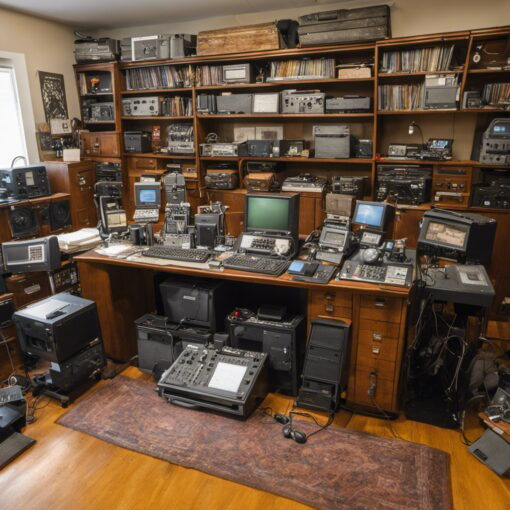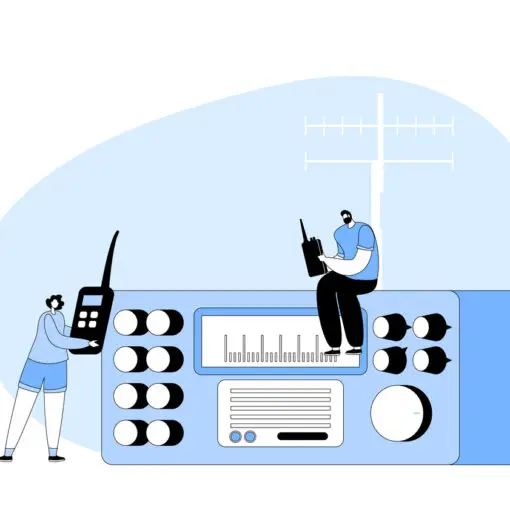Ham radio, or amateur radio, is a popular hobby and communication medium that has attracted countless enthusiasts worldwide. With its ability to create long-distance connections and transmit a wide range of information, ham radio offers users various modes for different communication purposes. These modes allow operators to send and receive voice, text, image, and data transmissions amidst a variety of environments and techniques.
Some of the most common modes used by ham radio operators include Amplitude Modulation (AM), Single Sideband (SSB), Frequency Modulation (FM), and Continuous Wave (CW). Each mode has distinct features that cater to the specific needs and preferences of the operators. For instance, AM and FM are traditional modulation schemes, while SSB is more efficient for long-distance communication, and CW, also known as Morse code, is a classic yet effective communication method.
In addition to these conventional modes, a growing number of digital modes, such as packet radio, PSK31, and automatic link establishment (ALE), have gained popularity for their ability to transmit and receive data efficiently. Voice Over Internet Protocol (VoIP) also has a place in the world of ham radio, offering users ease of communication through the internet. As the technologies and interests of ham radio operators evolve, these diverse modes of operation continue to facilitate connections and foster a unique community of hobbyists and professionals.
Fundamentals of Ham Radio
Amateur Radio and Its Purpose
Amateur radio, often referred to as ham radio, is a hobby and a service that focuses on the non-commercial exchange of information, experimentation, self-training, and emergency communication. Ham radio operators use various modes of transmission to communicate, including voice, text, image, and data. The primary goal of amateur radio enthusiasts is to improve their technical skills, socialize with like-minded individuals, and provide assistance in emergency situations.
Frequency Bands and Electromagnetic Radiation
Ham radio operates within specific frequency bands on the radio spectrum, which is part of the larger electromagnetic spectrum. These bands have been allocated by regulatory agencies and are designated for amateur radio use. The frequency bands used by ham radio operators range from very low frequency (VLF) to extremely high frequency (EHF), offering a wide variety of options for communication and experimentation.
Electromagnetic radiation consists of oscillating electric and magnetic fields, which propagate through space as waves. The frequency and wavelength of these waves determine their respective properties, such as their ability for penetration, propagation characteristics, and absorption by objects.
Radio Spectrum and Bandwidth
The radio spectrum is the range of all possible frequencies of electromagnetic radiation. Within this spectrum, different frequency bands are allocated for various purposes, such as television broadcasting, mobile communication, or amateur radio operation. Ham radio operators have access to specific sections of the spectrum to perform their activities without interfering with other services. Here’s a brief overview of some popular ham radio bands:
- High Frequency (HF) bands: 3-30 MHz
- Very High Frequency (VHF) bands: 30-300 MHz
- Ultra High Frequency (UHF) bands: 300-3000 MHz
Bandwidth refers to the range of frequencies that a signal occupies in the spectrum. Narrower bandwidths result in clearer signals and lower interference, while wider bandwidths allow for more information to be transmitted but may cause more interference with neighboring signals.
Antennas and Wavelength
Antennas are crucial components of any ham radio setup. They are responsible for converting electrical signals into electromagnetic waves and vice versa. The design and efficiency of an antenna greatly influence the quality of the transmitted and received signals.
The wavelength of a radio wave is the distance between successive wave crests, and it is inversely proportional to the frequency. As the frequency increases, the wavelength decreases, and these properties have implications on the design of antennas. For instance, lower frequency signals (longer wavelengths) require larger antennas for efficient transmission and reception.
Different antenna designs cater to the needs of various frequency bands and applications, including:
- Dipole antennas
- Yagi antennas
- Vertical antennas
In summary, ham radio operators require a thorough understanding of the fundamentals, including frequency bands, electromagnetic radiation, radio spectrum, bandwidth, and antennas, to efficiently operate within this hobby and service.
Modes of Communication in Ham Radio
Amplitude Modulation (AM)
Amplitude Modulation (AM) is a basic mode of communication in ham radio, where the amplitude of the signal is adjusted according to the input voice signal. This method changes the phasor amplitude while maintaining a constant frequency and phase. AM is less frequently used in amateur radio due to its relatively large bandwidth and power consumption. However, AM enthusiasts still operate mostly in the HF bands, providing a unique experience with its distinctive sound quality.
Single Sideband (SSB)
Single Sideband (SSB) is the most common voice mode used in the HF bands in amateur radio. It is a form of AM that suppresses one sideband and the carrier, which results in more efficient use of power and bandwidth. SSB is predominantly used for long-distance communication, as it offers better signal-to-noise ratios compared to AM or FM. There are two types of SSB:
- Upper Sideband (USB): Commonly used for 10-, 12-, 15-, and 2-meter radiotelephony transmissions.
- Lower Sideband (LSB): Used on 40-, 80-, and 160-meter radiotelephony transmissions.
Frequency Modulation (FM)
Frequency Modulation (FM) is a popular mode for VHF and UHF ham radio communications. In FM, the frequency of the carrier wave is varied according to the input voice signal, while amplitude and phase remain constant. FM provides better immunity to noise and interference hence it’s commonly used for local and regional communications. FM is widely used for repeater systems, handheld radios, and mobile radios, allowing for clear voice communication over shorter distances.
Continuous Wave (CW)
Continuous Wave (CW) is a simple and classic mode of communication in amateur radio, most commonly associated with Morse code. In CW, a continuous sine wave is transmitted without any variation in amplitude or frequency. Breaks in the signal represent the Morse code characters, sent by the operator using a telegraph key. CW has a narrow bandwidth and offers excellent signal-to-noise performance, making it a popular choice for long-distance communication under challenging conditions.
In summary, ham radio offers various modes of communication, each with its specific advantages, techniques, and applications. Whether it’s the simplicity and efficiency of CW or the broader capabilities of FM and SSB, amateur radio enthusiasts have plenty of options to explore and enjoy in the realm of radio communication.
Digital Modes and Technologies
Introduction to Digital Modes
Digital modes are a significant aspect of modern ham radio operation, leveraging computer technology to transmit and receive data via radio waves. These modes make efficient use of bandwidth and provide various communication options for amateur radio operators. Digital technology has revolutionized ham radio in numerous ways, offering diverse modulation modes, advanced data encoding techniques, and robust error correction algorithms.
Radioteletype (RTTY)
One of the earliest digital modes is Radioteletype (RTTY), which enables operators to send and receive text messages using the radio spectrum. RTTY uses frequency shift keying (FSK) to transmit data, allowing distinct audio frequencies to represent binary values. This mode is still popular today, particularly for contesting and long-distance communication.
PSK31
PSK31 is a popular narrowband digital mode that utilizes binary phase-shift keying. It is designed for efficient keyboard-to-keyboard communication and has become widely used by ham radio operators for casual conversation and contesting. This mode occupies around 100 Hz of bandwidth, enabling effective communication at low power ARRL.
JT65
JT65 is a digital mode renowned for its ability to decode weak signals. Originally created for moonbounce (EME) communication, it has become popular for very low power (QRP) operations and long-distance contacts. JT65 utilizes precise time synchronization and multiple-frequency shift keying to provide robust error correction and reliable communication.
D-STAR
D-STAR is a digital voice and data protocol primarily used on VHF and UHF bands. Developed by the Japan Amateur Radio League (JARL), this mode allows for simultaneous voice and data transmission, enabling extras like GPS location information. D-STAR uses digital repeaters and internet gateways to extend communication range and connect users worldwide.
DMR
Digital Mobile Radio (DMR) is another digital voice and data protocol adopted by amateur radio operators. Designed for commercial use and later adapted for ham radio, this mode is highly efficient and versatile. It supports features such as internet connectivity, location tracking, and text messaging while providing clear audio quality.
FT8
FT8 is currently one of the most popular ham radio digital modes. It was developed by the creators of WSJT (Weak Signal Communications by K1JT) and is specifically designed for weak-signal, high-frequency bands. FT8 excels at making contacts with minimal signal strength and in challenging conditions, making it a preferred choice for DXing and establishing low-power contacts ARRL.
Emergency and Portable Operations
Emergency Communication Benefits of Ham Radio
Ham radio, also known as amateur radio, serves as a valuable tool for emergency communication. One of the main reasons that amateur radio exists is to provide emergency communications in times of crisis or natural disasters. Part §97.1 of the rules and regulations that govern amateur radio states that one of its goals is to recognize and enhance the value of the amateur service to the public.
Some benefits of ham radio in emergency communications include:
- Flexibility: Ham radio operators can use different modes and frequencies to reach out to others. This is particularly useful during disasters when conventional communication systems may fail.
- Portability: Ham radio equipment is often easy to transport and set up in remote locations. As a result, operators can establish communication links quickly to assist in emergency situations.
- APRS: The Automatic Packet Reporting System (APRS) is a digital communication protocol that enables real-time sharing of information, such as location data and messages. This feature is invaluable in coordinating rescue efforts and relaying critical information during emergencies.
Portable and Mobile Equipment
Portable operation is a common practice among ham radio operators, allowing them to operate their stations from various locations away from their licensed address. This often involves using a self-contained radio package, complete with a power source, like solar panels or batteries.
Some aspects of portable and mobile ham radio equipment include:
- Lightweight and compact: Portable equipment is designed to be easy to carry and transport, enabling operators to take their stations to remote locations or areas affected by emergencies.
- Solar-powered: Many portable stations utilize solar power as an energy source, making them self-sufficient and reliable in areas without access to electricity.
- Multiple modes: Ham radio operators can use various modes such as AM, SSB, FM, and CW to establish communication links during portable operations, enabling them to remain connected even under challenging conditions.
In summary, emergency and portable operations are vital aspects of ham radio, enabling operators to provide life-saving communication services in times of crisis and disaster. Apart from that, portable operation also supports the spirit of experimentation and exploration that defines the amateur radio community.
Advanced Equipment and Techniques
VOIP and System Fusion
Voice over Internet Protocol (VOIP) is a technology that allows ham radio operators to communicate over the internet instead of using radio waves. This can be accomplished by using advanced equipment such as digital interface boxes and specialized software. One popular system that incorporates VOIP technology is System Fusion, developed by Yaesu. It combines traditional analog communication with digital technology for enhanced clarity and fidelity, and allows for more efficient use of available bandwidth.
Amateur Television
Amateur Television (ATV) is another advanced operating mode in ham radio, where operators transmit and receive video signals, often using live streaming. This mode requires specialized equipment, including video cameras, transceivers, antennas, and even digital modulation techniques for optimizing image quality. Common formats for ATV include Phase Shift Keying (PSK) and Frequency Modulation (FM), where different modulation schemes are used for transmitting binary data.
Amateur Teleprinting over Radio
Amateur Teleprinting over Radio (ATR) is a mode that involves sending text-based messages over ham radio frequencies. This can be done using a variety of methods, such as Multiple Frequency Shift Keying (MFSK), JS8, and other digital modes that convert text to audio tones for transmission. Operators typically use Lower Side Band (LSB) and Upper Side Band (USB) for transmitting ATR signals. Advanced equipment necessary for ATR includes computers, digital interface boxes, and specialized software programs.
Frequently Asked Questions
What is PSK31?
PSK31 is an abbreviation for Phase Shift Keying at 31 baud. It’s a popular digital mode of communication in ham radio that uses varying phases to represent binary data. PSK31 is considered to be highly efficient and allows for keyboard-to-keyboard chat in real-time. Thanks to its narrow bandwidth and error correction, PSK31 can be used in weak signal conditions with relatively low power.
How does Radioteletype work?
Radioteletype (RTTY) is an older digital mode used in ham radio for sending text messages through radio waves. It relies on the frequency shift keying (FSK) method, which uses two different frequencies to represent binary data. RTTY transmissions use the Baudot-Murray code, a 5-bit character set, for encoding messages. Despite being less efficient than newer modulation techniques, RTTY remains popular due to its simplicity and compatibility with various amateur radio equipment.
What is AMTOR?
AMTOR (Amateur Teleprinting Over Radio) is a mode of communication in ham radio, designed as an improvement over the traditional RTTY. It functions similarly to RTTY by encoding text messages for transmission through FSK. However, AMTOR introduces an error detection and correction feature by implementing an Automatic Repeat Request (ARQ) system. This makes AMTOR more reliable and less prone to errors when compared to RTTY, especially in challenging signal conditions.
What is MT63?
MT63 is a digital mode for ham radio that offers superior performance in noisy environments. It uses multicarrier frequency modulation with 64 tones to transmit data. The technique allows for strong error correction and robustness against interference, making MT63 ideal for use in portable and emergency communication setups. MT63 operates in various bandwidths (500 Hz, 1 kHz, or 2 kHz) to accommodate different speed requirements and channel conditions.
What is Slow-scan television?
Slow-scan television (SSTV) is a mode in ham radio that enables the transmission of still images using a narrow bandwidth. The images are divided into horizontal lines and converted into an analog signal. This signal is sent over the airwaves using amplitude modulation (AM), frequency modulation (FM), or single sideband (SSB) techniques. On the receiving end, the signal is decoded and reconstructed into an image. SSTV is popular among radio amateurs for exchanging photographs and artwork during contests or casual QSOs (conversations).
How to identify HF digital modes?
Identifying HF digital modes can be a challenge, especially for new ham radio operators. However, there are some strategies to help recognize various digital modes. Familiarizing yourself with the audio patterns and spectral characteristics of each mode is essential. Additionally, using software tools like fldigi or amateur radio websites with audio samples can improve your ability to distinguish between different digital signals. Regular practice and experience will also make it easier to identify HF digital modes over time.





